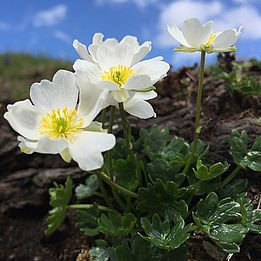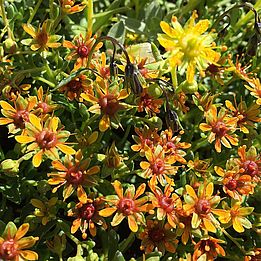29.01.2018 | News WSL
A study conducted by the University of Vienna and the Swiss Federal Institute for Forest, Snow and Landscape Research (WSL) has shown that as a result of rising temperatures and increasing nutrient inputs, most mountain plants are moving to higher elevations faster at the lower limit of their range than at the upper limit. Consequently, high-alpine species are facing mounting competitive pressure.
Numerous studies show that climate change is shifting the upper range of alpine plants to higher elevations. This 'flight to higher elevations' is a typical reaction to constantly rising temperatures, increased airborne nutrient inputs and longer growing seasons. Relatively little is known about the changes occurring at the lower limit of plants' distribution range. Yet knowledge about how species are reacting across their entire range is needed if we are to make accurate assessments of the threats posed to them.
Researchers from the WSL and University of Vienna spent the past few years analysing data from numerous distribution studies and have now pieced together a more complete picture of how alpine plants are responding to global climate change. Key trends: For most species, both range limits are moving to higher elevations as a result of climate change. As a result, many plants are becoming more common within their range. This applies in particular to those species requiring the most nutrients, which are benefiting from man-made nutrient inputs. However, species at lower elevations are reacting faster and are thus likely to move closer to high alpine flora. The results of the study were published in the prestigious journal Proceedings of the National Academy of Sciences of the USA (PNAS).
Most plants are shifting to higher elevations
The team from WSL and the University of Vienna analysed changes along the entire altitudinal range of 183 alpine plants, comparing data on the distribution of these species in the Austrian, Swiss, Italian, Slovenian and German Alps during the first half of the 20th century with data on their current ranges in the same area. "The majority of alpine flora seem to be slowly and evenly shifting their entire ranges to higher elevations and seem to have benefited from climate change so far", says Sabine Rumpf from the University of Vienna, who was the lead author of the study. On average, the species in question have expanded their range upwards by between 20 and 35 m. Also, many species now occur more frequently within their range.
However, the results reveal big differences between different species. One typical species, in that both the lower and the upper limits of its range are shifting upwards, is the Alpine buttercup (Ranunculus alpestris), whose lower range limit has shifted upwards very substantially, by 385 m, whereas its upper limit is now just 21 m higher than it was. Today, this species colonises an elevation band that is 33% narrower than it was a century ago. The elevation band of the white alpine pasqueflower (Pulsatilla alpina) has even shrunk by 43%, its lower range limit climbing markedly, whilst its upper range limit is now even 12 m lower than it used to be. Other species, like yellow mountain saxifrage (Saxifraga aizoides), have extended their range both downwards and upwards. By contrast, the elevations of both the lower and upper limits of the range of the hairy primrose (Primula hirsuta) are lower today than they used to be.




Data from the entire Alpine arc
"The special thing about this study is that we examined a large number of data sets from many Alpine regions", says co-author Niklaus Zimmermann of the WSL. "Accordingly, we can corroborate reliable trends in spite of species-specific and regional differences. Most previous studies were limited to smaller regions and focussed primarily on plants' upper range limits. The diverse range of data from the present study permit the clear conclusion that the lower range limit of many species is shifting to higher elevations faster than the upper limit, resulting in their population of a narrower elevation band than before. As a consequence, at higher altitudes space is at a premium, with species that are spreading to higher elevations piling greater competitive pressure on others already growing there.
Unequal speeds mean there are winners and losers
However, changes are not occurring at the same speed at all elevations. "The lower a species' altitude limit used to be, the higher their maximum elevation now is", explains Sabine Rumpf. "Also, species with a main range that used to be at a lower elevation have been able to become more common." The overall picture for Alpine flora is that species growing at lower and medium altitudes are reacting faster, while species at alpine elevations are reacting more sluggishly, and sometimes even in the opposite direction. The unequal speeds and directions of these changes mean that winners and losers from ongoing global climate change appear to be emerging along altitudinal gradients. Just under 20% of the species studied, most of which thrive in nutrient-poor habitats, seem to be among the losers as a result of recent changes. Today, they are markedly rarer than they used to be and populate a narrower altitude interval at a higher elevation, whereas most species pushing upwards from lower elevations figure among the winners.
Contacts ¶
Original publication ¶
Copyright ¶
WSL and SLF provide image and sound material free of charge for use in the context of press contributions in connection with this media release. The transfer of this material to image, sound and/or video databases and the sale of the material by third parties are not permitted.

